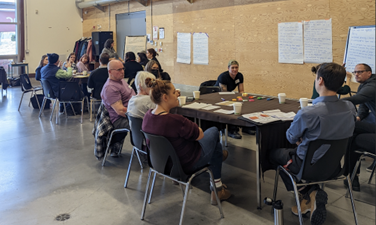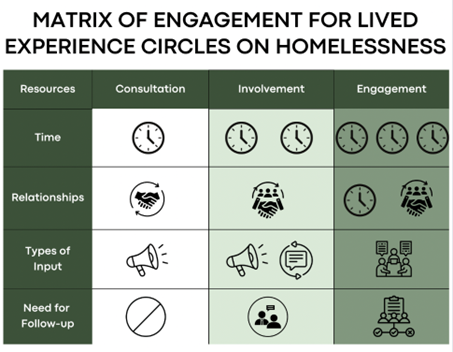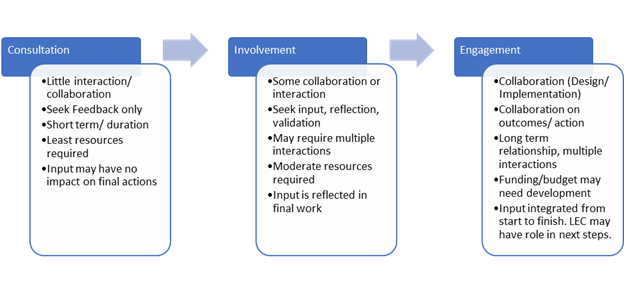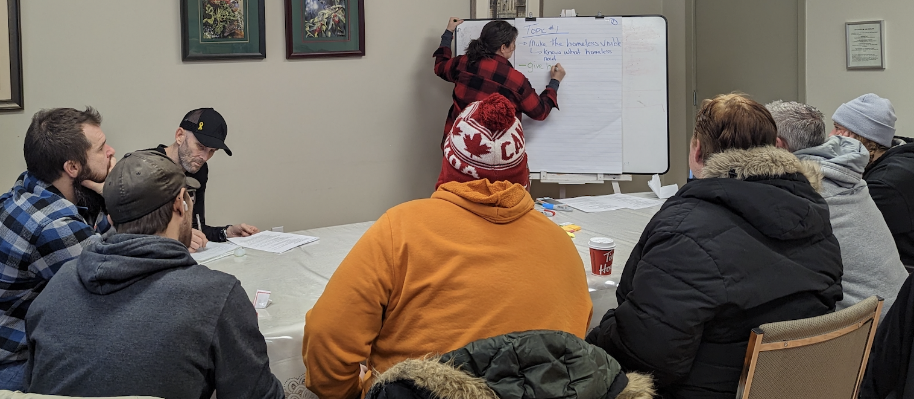 It is common to hear organizations or governments talk about gathering feedback from the community. In addressing issues such as homelessness, we expect to see consultation from a wide variety of stakeholders including people with lived or living experience (PWLLE). Gaining input in a way that is respectful, appropriate, and beneficial to everyone involved is complex. Small to medium-sized communities may not have the experience or resources to devote to these efforts.
It is common to hear organizations or governments talk about gathering feedback from the community. In addressing issues such as homelessness, we expect to see consultation from a wide variety of stakeholders including people with lived or living experience (PWLLE). Gaining input in a way that is respectful, appropriate, and beneficial to everyone involved is complex. Small to medium-sized communities may not have the experience or resources to devote to these efforts.
Lived/Living Experience Circles (LLECs) that serve a whole community are dedicated groups that provide access to the voice of PWLLE and can support communities in addressing issues like homelessness. While some organizations have access to existing circles, a scan of the literature revealed most community organizations do not.
While information is available to help organizations conduct consultations or host short-term circles, there is little guidance for creating structured groups that are designed to serve an entire community. For this reason, our team set out to answer the following questions:
- What resources are needed to create an LLEC?
- How should engagement be approached?
- How are People with Lived/Living Experience (PWLLE) supported with training and funds?
This blog unpacks our engagement matrix for lived experience circles on homelessness. We also aim to highlight how different levels of engagement could be approached, including what resources and supports might be necessary to sustain them.
Why Create a Community-Based Lived/Living Experience Circle
Our research indicates that small/mid-sized communities would benefit from having a core group of PWLLE organized as a community circle to support local decision-making and assist in building out supports for people impacted by homelessness. Specifically, we identified 5 areas where a community-based LLEC could help address issues related to homelessness.

Figure: See our Community Report for more information
The Matrix of Engagement
 There are toolkits and guides that can support with the operation of a lived/living experience circle, but there is little written about models for engagement. According to research, how communities plan for resources and supports is a critical aspect of creating a successful LLEC.
There are toolkits and guides that can support with the operation of a lived/living experience circle, but there is little written about models for engagement. According to research, how communities plan for resources and supports is a critical aspect of creating a successful LLEC.
Our matrix supports emerging community-based LLECs to consider:
- How to handle requests for engagement
- How to ensure that the circle is adequately resourced, and that the input and feedback they provide is both integrated and used respectfully in community work
Based on our research, we created a matrix of engagement to better guide how engagement is approached. Our matrix expands on resources such as the IAP2.
Engagement Categories
In our engagement matrix, we represent the lowest levels of engagement on the left and progress to deeper levels of engagement on the right.

1. Consultation
The first level of contact with an LLEC is referred to as consultation. Consultation involves the least amount of time and engagement from participants. These are generally short-term or single interactions where the LLEC is being consulted to provide input on an idea, policy, program, or opportunity. It is most appropriate for organizations seeking feedback with no expectation of follow-up. This level of interaction requires little to no relationship building between the organization and the LLEC.
To prepare LLEC members to engage in consultation activities, they may need training on the use of video conferencing technology and/or assistance to read or access materials. LLEC members may also need support with addressing perceived power differences to help them include their voices in conversations.
2. Involvement
At the mid-point of the continuum is involvement. This level is characterized by a deepening commitment from LLEC members and the organizations seeking their input. These interactions are generally expected to take more time and involve multiple interactions. A group seeking feedback may come back several times to gather additional information and explain how the original input has been incorporated. Organizations should understand that there will be an expectation for them to follow up with the LLEC and provide closure to the interaction.
Due to the increased expectation of time spent, it is recommended that organizations plan for some form of compensation for LLEC members. If financial compensation is difficult, consider providing resources such as transportation (bus tickets), childcare or food at meetings. To prepare LLEC members to undertake involvement activities, they may benefit from training on meeting facilitation, dealing with conflict, or use of computer technology such as how to use Microsoft Word, create presentations using PowerPoint or access email.
3. Engagement
The deepest level of interaction is engagement. Organizations wishing to interact with the LLEC on this level should be seeking to build (or have existing) substantive and deep relationships. At this level, both the LLEC and the organization(s) should be looking to co-create/collaborate on an initiative. The time required for engagement is usually substantive and generally will need to be supported with resources. Grants or other funding may be required to support the activities both in planning and implementation. These initiatives may include:
- System-wide endeavours
- Large-scale research projects
- Significant advocacy activities
Interactions at the engagement level will generally be time-consuming and require multiple interactions to complete. It is also likely that both a smaller working group and the entire LLEC group will be needed at different points of the project. Additionally, the LLEC may want to engage in consultation with a broader group of PWLLE.
Preparing LLEC members to work on engagement activities will likely require training. LLEC members may need more advanced facilitation skills to support with gathering information from a broader PWLLE audience, as well as team building skills. They may also need support and training in organizing and managing projects and doing basic internet searches. Another area where LLEC members may require support is in working with professionals, such as researchers or librarians, to gather information or videographers/graphic designers to help create reports or videos.
Using the Matrix
This matrix supports communities, organizations and LLECs to set expectations about the work, identify resource needs in advance and ensure that proper supports are in place. LLEC members can use this matrix to help communicate with those who want their support and avoid misunderstandings.
LLECs are generally groups of individuals who are volunteering their time and have limited ability to work without compensation. Organizations should be reminded that while their employees are paid to engage with PWLLE, this is not the case for LLECs.
Next Steps

We have already begun working with institutions including, Selkirk College, to address challenges in their communities using our matrix/toolkit. Moving forward our research team is seeking out other communities interested in piloting the matrix and using the toolkit. This will allow us to further build out resources and continue to build knowledge in this area.
If you are interested in piloting the matrix or using the toolkit, please contact Kerry Rempel at krempel@okanagan.bc.ca.
Resources
Our work was supported by the Vancouver Foundation, City of Penticton, Social Development Department, United Way BC, Southern Interior Region and Ask Wellness Society, Penticton
You can access the public community resources from our research project at the following links:
Note: The authors would like to thank their co-researchers, Stephanie Griffiths, Jamie Lloyd-Smith, Shawn Kelly and Bobby Hines for their support in the development of this blog.
_____
This post is part of our #CAEH23 blog series which highlights research on preventing and ending homelessness that is being presented at the 2023 National Conference on Ending Homelessness, November 8-10 in Halifax, NS. Learn more about the authors’ work through their presentation in the Designing for Equity in Homelessness Solutions: Tools for Transformation session on Thursday, November 9th at 10:00 a.m.

